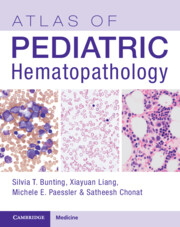Book contents
- Atlas of Pediatric Hematopathology
- Atlas of Pediatric Hematopathology
- Copyright page
- Contents
- Contributors
- Section I Peripheral Blood
- Section II Normal and Non-neoplastic Hematolymphoid Diseases
- Section III Mature Lymphoid Neoplasm
- Section IV Precursor Hematopoietic Neoplasms and Related Neoplasms
- Chapter 13 Precursor Lymphoblastic Leukemia/Lymphoma
- Chapter 14 Blastic Plasmacytoid Dendritic Cell Neoplasm
- Chapter 15 Acute Myeloid Leukemia and Related Precursor Neoplasms
- Chapter 16 Myeloproliferative Neoplasms
- Chapter 17 Myelodysplastic/Myeloproliferative Neoplasms
- Chapter 18 Childhood Myelodysplastic Syndrome
- Chapter 19 Germline Predisposition to Myeloid Neoplasia
- Chapter 20 Germline Predisposition to Lymphoid Neoplasm
- Chapter 21 Mastocytosis and Myeloid Lymphoid Neoplasms with Eosinophilia
- Section V Histiocytic Neoplasm and Miscellaneous Bone Marrow Diseases
- Index
- References
Chapter 21 - Mastocytosis and Myeloid Lymphoid Neoplasms with Eosinophilia
from Section IV - Precursor Hematopoietic Neoplasms and Related Neoplasms
Published online by Cambridge University Press: 25 November 2023
- Atlas of Pediatric Hematopathology
- Atlas of Pediatric Hematopathology
- Copyright page
- Contents
- Contributors
- Section I Peripheral Blood
- Section II Normal and Non-neoplastic Hematolymphoid Diseases
- Section III Mature Lymphoid Neoplasm
- Section IV Precursor Hematopoietic Neoplasms and Related Neoplasms
- Chapter 13 Precursor Lymphoblastic Leukemia/Lymphoma
- Chapter 14 Blastic Plasmacytoid Dendritic Cell Neoplasm
- Chapter 15 Acute Myeloid Leukemia and Related Precursor Neoplasms
- Chapter 16 Myeloproliferative Neoplasms
- Chapter 17 Myelodysplastic/Myeloproliferative Neoplasms
- Chapter 18 Childhood Myelodysplastic Syndrome
- Chapter 19 Germline Predisposition to Myeloid Neoplasia
- Chapter 20 Germline Predisposition to Lymphoid Neoplasm
- Chapter 21 Mastocytosis and Myeloid Lymphoid Neoplasms with Eosinophilia
- Section V Histiocytic Neoplasm and Miscellaneous Bone Marrow Diseases
- Index
- References
Summary
Mastocytosis is defined as a clonal proliferation of neoplastic mast cells in one or more organ systems. It is broadly separated into two categories of cutaneous mastocytosis and systemic mastocytosis, of which the latter can include cutaneous involvement. In the 2016 World Health Organization (WHO) Classification of Tumours of Haematopoietic and Lymphoid Tissues, mastocytosis was separated into its own category due to its heterogeneous clinical manifestations ranging from spontaneously resolving skin lesions in pediatric cutaneous mastocytosis to highly aggressive malignancies such as mast cell leukemia with short survival and multiorgan involvement [1, 2].
- Type
- Chapter
- Information
- Atlas of Pediatric Hematopathology , pp. 247 - 256Publisher: Cambridge University PressPrint publication year: 2023



